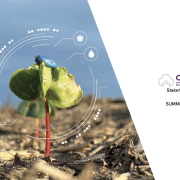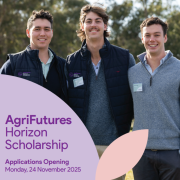Good attendance and engagement from growers and the wider industry has provided Cotton Australia and CRDC with important early guidance on the future direction of the myBMP program, traceability, the CRDC-led cotton industry data platform and human rights.
The Growers’ Voice and Carbon Chat Tour kicked off in Central Qld in late July with events at Banana and Emerald. The roadshow then moved to the Macquarie, Southern Valleys, Upper and Lower Namoi, Walgett, the Macintyre and Border Rivers, finishing up in the Darling Downs of Qld in mid-September.
The tour was an initiative of Cotton Australia and CRDC working with Cotton Grower Associations to discuss and receive grower input into the Strategic Roadmap for Australian Cotton. The Roadmap is a detailed plan to ensure the Australian cotton industry remains competitive and a supplier of choice in a changing global fashion and textiles market. The Roadmap covers five key topic areas: traceability, industry data, sustainably-certified cotton/myBMP, human rights and Australian cotton promotion.
These topics were used for the basis of the discussions, held after presentations from Cotton Australia CEO Adam Kay on traceability, CRDC Executive director Allan Williams on the myBMP review and Cotton Industry Data Platform, and Cotton to Market Lead Brooke Summers explaining the finer points of human rights and the relevance to Australian growers. Growers also had the opportunity to raise local issues directly with Allan and Adam.
The Carbon Chat component of the tour was presented by CottonInfo Energy, Climate and Carbon Technical Lead Jon Welsh, offering insights into the science, economic, market access and policy angles of carbon, along with identifying gaps in grower resources and information.
“We’re really encouraged by the feedback which will be incorporated into our plans as the Roadmap becomes operational. It’s fair to say that we’re still in a research and discovery phase as we work out the best investments and direction for the industry and we’re committed to making the process as collaborative as possible,” Adam said.
A core theme is the need to ensure any value proposition is clear, additional administration burden is limited and that there is supply chain transparency in terms of the premiums available for sustainable, traceable cotton from Australia.
myBMP review
As a part of the Roadmap development, CRDC commissioned a review to assess myBMP’s effectiveness, relevance and future fitness, and outline how the industry can best meet new and emerging requirements for demonstrating sustainability credentials. The review, once complete, will include recommendations for improvements to the program, potentially including updates to its structure, content, and reporting mechanisms.
“We had candid and wide-ranging discussions about the challenges, benefits, and future direction of the myBMP program that we’ve taken on board,” Allan said.
“We heard the program is valued for helping growers meet legal and regulatory requirements, offering protection in areas like liability insurance and environmental compliance.
“We also heard some of the barriers to adoption, including a lack of financial incentive and competing demands for time, making it harder for growers to turn their attention to myBMP.”
The cotton industry data platform
While external stakeholders regularly highlight the need for impact data — such as irrigation efficiency and carbon footprint — to meet evolving sustainability and ESG goals, growers emphasised the importance of the data they collect also benefiting their operations and supporting their decision making.
The industry data platform is being designed to solve issues growers currently face around collecting, processing and utilising their data to improve the economic and sustainability outcomes of their operation.
“There’s interest in a flexible, agnostic data platform that could support multiple certification pathways and reduce duplication of effort, automate data collection and integrate with existing systems (e.g. John Deere, AgWorld) to reduce double handling,” Allan said.
“The cotton industry data platform promises voluntary participation, secure data handling, and analytics capabilities that will be able to help growers meet market demands for traceability and sustainability reporting, potentially unlocking premiums."
Engagement across all discussion topics
In general, growers were engaged in all topics on the agenda, with an acute awareness that they are operating in a constantly evolving marketplace.
“It’s clear that through the stakeholder engagement work already done, and also growers and industry being more exposed to global issues, that there’s strong support for the need to make sure we are ready for a changing global and Australian environment,” Brooke said.
“Growers are generally surprised to hear that we don’t have a connected, integrated traceability system like our competitors and like the other cotton sustainability programs in the market and feel we needed to move quickly to catch up on that topic."
In terms of human rights, there were a number of scenarios put to the participants which prompted really interesting discussions about what does or doesn’t constitute human rights issues and what some of the gaps in our data and verification may be. This topic will be included in the review of myBMP to ensure the social compliance aspects of cotton production in Australia are properly covered.
“While we know that we are low risk for human rights violations here we still need to be collecting the right evidence to verify those claims. Global businesses including fashion brands and merchants are adopting due diligence approaches, and this will soon be mandated for every product sold in the EU,” Brooke said.
“We are a global industry and human rights in textile supply chains is a huge issue for cotton across the value chain.”
This is an edited version of an article that originally appeared in the Spring 2025 edition of CRDC's Spotlight magazine. You can read this edition online here, and subscribe for future editions here.


